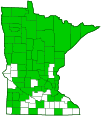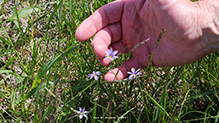strict blue-eyed grass
(Sisyrinchium montanum var. montanum)
Conservation • Wetland • Description • Habitat • Ecology • Use • Distribution • Taxonomy
Description |
Strict blue-eyed grass is a common prairie wildflower. It is native to the northern and south-central United States and most of Canada. It was introduced in France, probably during the First World War. It is now naturalized throughout most of Europe. In the U.S., it is found in moist meadows and open woodlands and on stream banks. It grows under full sun in loamy soil. It often forms clumps. Strict blue-eyed grass is a 4″ to 20″ (10 to 50 cm) tall, erect, perennial forb that rises on 2 to 6 basal leaves and one or more aerial stems from fibrous roots. It there are underground horizontal stems (rhizomes), they are barely discernible or obscure. There is some disagreement in the literature about the presence of a waxy film (glaucous) on the stems and leaves. According to Flora of North America, the plant is “not glaucous.” According to Gleason & Cronquist (1992), the plant is “glaucescent”, meaning becoming glaucous. According to Michigan Flora (Voss, 1972) the plant is “with a more glaucous aspect.” According to Minnesota Flora (Chadde, 2019), the plant is “waxy”. The leaves are mostly from the base of the plant (basal), but one or more may arise low on the stem. The leaf blade is grass-like (linear), narrow, hairless, and 1⁄16″ to ⅛″ (1.5 to 3.0 mm) wide, almost as long and wide as the stem. The aerial stem is unbranched, flattened, obviously winged, hairless, and 1⁄16″ to ⅛″ (2.0 to 3.7 mm) wide. The margins in western populations are toothed near the top, but in eastern populations they are not toothed. The inflorescence is a single flower or a single, unstalked, flattened, fan-shaped cluster (cyme) of 2 to 11 flowers at the end of the stem. The cyme is subtended by and partially enclosed by a pair of claw-like bracts. Together the bracts are called a spathe, and each bract is called a spathe. The spathes are hairless, folded (keeled), and usually green or bronze. They rarely have purplish margins. The keel usually has very small teeth. The outer spathe is 1 7⁄16″ to 3″ (36 to 76 mm) long. It is always 9⁄16″ to 1 13⁄16″ (14 to 46 mm) longer than the inner spathe, and it is usually at least ⅝″ (16 mm) longer. It is folded lengthwise and fused at the base for 1⁄32″ to ⅛″ (1.0 to 3.5 mm), partially enclosing the base in the inner spathe. The inner spathe has very thin, 1⁄256″ to 3⁄256″ (0.1 to 0.3 mm) wide, membranous, translucent margins from the base to 1⁄32″ to 5⁄32″ (0.9 to 4.3 mm) from the tip, which is green. The margin of the outer spathe is distinct all the way to the base. The flowers are about ¾″ (20 mm) in diameter. They are at the end of a slender, hairless, ¾″ to 1″ (2.0 to 2.5 mm) long stalk. They are drooping when in bud, becoming erect when in flower. Each flower has 3 petals, 3 petal-like sepals (6 tepals), 3 stamens, and 3 styles. The tepals are widely spreading, inversely lance-shaped, and ⅜″ to 9⁄16″ (9.0 to 14.5 mm) long. They are notched at the rounded tip, and they have a bristle-like extension at the tip. They are usually dark bluish violet, sometimes blue, and they are yellow at the base. The stamens have white filaments and yellow anthers. The filaments are fused for most of their length around the styles. The styles extend between the filaments and beyond the anthers. The fruit is a tan to dark brown, ⅛″ to ¼″ (4 to 6.8 mm) long, globe-shaped to inversely egg-shaped capsule containing many seeds. It is sometimes tinged purple at the tip. It is erect to spreading at the end of a stalk (pedicel). |
Height |
4″ to 20″ (10 to 50 cm) |
Flower Color |
Usually dark bluish violet, rarely blue, and yellow at the base |
Similar Species |
Prairie blue-eyed grass (Sisyrinchium campestre) flowers are usually pale violet or light blue, sometimes white. |
Habitat |
Dry to moderate moisture. Moist meadows, open woodlands, and stream banks. Full sun. Loamy soil. |
Ecology |
Flowering |
May to July |
Pests and Diseases |
|
Use |
|
Distribution |
||
|
Sources Biodiversity occurrence data published by: Minnesota Biodiversity Atlas (accessed through the Minnesota Biodiversity Atlas Portal, bellatlas.umn.edu, 6/29/2024). |
|
| 6/29/2024 | ||
Nativity |
||
Native |
||
Occurrence |
||
Common |
||
Taxonomy |
|
Kingdom |
|
Division |
Tracheophyta (Vascular Plants) |
Subdivision |
Spermatophytina (Seed Plants) |
Class |
Liliopsida (Monocots) |
Order |
Asparagales (Agaves, Orchids, Irises, and Allies) |
Family |
Iridaceae (irises and allies) |
Subfamily |
Iridoideae |
Tribe |
Sisyrinchieae |
Genus |
|
Section |
Sisyrinchium |
Species |
Sisyrinchium montanum (strict blue-eyed grass) |
There are two recognized varieties of Sisyrinchium montanum: S. m. montanum, common and widespread across the northern United States and southern Canada; and S. m. crebrum, restricted to the northeast. USDA PLANTS and NatureServe show S. m. crebrum as native to Minnesota. However, there are no records of it in the state, and the Minnesota DNR (MNTAXA) does not list it for the state. |
|
Subordinate Taxa |
|
|
|
Synonyms |
|
Sisyrhinchium alpestre Sisyrinchium alpestre Sisyrinchium heterocarpum |
|
Common Names |
|
American blue-eyed-grass mountain blue-eyed grass strict blue-eyed grass |
|
Glossary
Cyme
A branched, flat-topped or convex flower cluster in which the terminal flower opens first and the outermost flowers open last.
Glaucous
Pale green or bluish gray due to a whitish, powdery or waxy film, as on a plum or a grape.
Keeled
Folded, as in a grass blade, or with a raised ridge, as in a grass sheath; like the keel of a boat.
Linear
Long, straight, and narrow, with more or less parallel sides, like a blade of grass.
Pedicel
On plants: the stalk of a single flower in a cluster of flowers. On insects: the second segment of the antennae. On Hymenoptera and Araneae: the narrow stalk connecting the thorax to the abdomen: the preferred term is petiole.
Rhizome
A horizontal, usually underground stem. It serves as a reproductive structure, producing roots below and shoots above at the nodes.
Sepal
An outer floral leaf, usually green but sometimes colored, at the base of a flower.
Spathe
One or two large bracts that subtend, hood, or sometimes envelope a flower or flower cluster, as with a Jack-in-the-Pulpit.
Tepal
Refers to both the petals and the sepals of a flower when they are similar in appearance and difficult to tell apart. Tepals are common in lilies and tulips.
What’s in a Name?
Contrary to its common name, strict blue-eyed grass is an iris, not a grass.
Visitor Photos |
||
Share your photo of this plant. |
||
This button not working for you? |
||
Luciearl |
 |
Dan W. Andree |
||
Blue-eyed Grass... Shows somewhat how small the flowers are when it blooms.… It seems to be blooming a lot now and I seen many little purplish flowers, but they all looked so similar and none much different than any other. |
||
MinnesotaSeasons.com Photos |
||
|
||
|
||

Slideshows |
|

Visitor Videos |
||
Share your video of this plant. |
||
This button not working for you? |
||
|
Other Videos |
||
Wild Iris Sisyrinchium montanum var montanum |
About
Jun 29, 2020 |
Mountain Blue-eyed Grass Wildflowers ~ Sisyrinchium montanum |
About
Jun 1, 2022 ❄ Order prints at www.ootophoto.com under Creative or Nature link or follow me on Facebook "The Snowflake Photographer" |

Visitor Sightings |
||
Report a sighting of this plant. |
||
This button not working for you? |
||
Luciearl |
Location: Fairview Twp. |
 |
Dan W. Andree |
Location: SNA in Norman Co. Mn. Shows somewhat how small the flowers are when it blooms.… It seems to be blooming a lot now and I seen many little purplish flowers, but they all looked so similar and none much different than any other. |
 |
MinnesotaSeasons.com Sightings |
||

|
Created: 6/30/2024 Last Updated: © MinnesotaSeasons.com. All rights reserved. |

